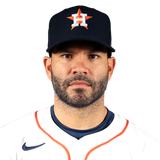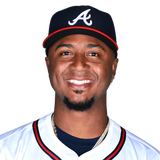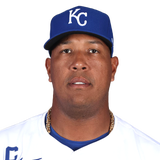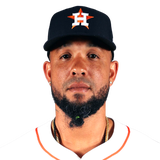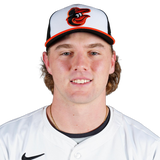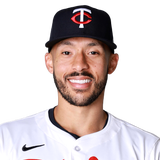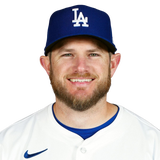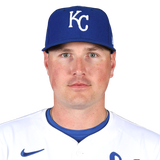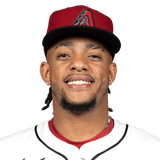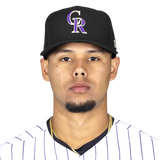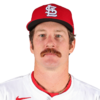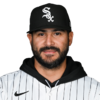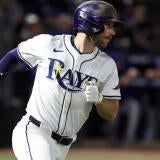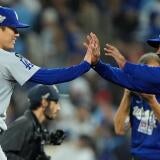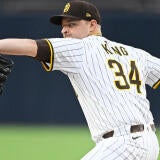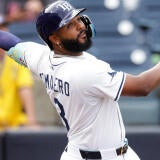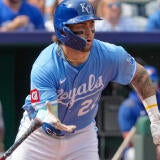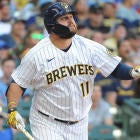SF
San Francisco
• #16
•
Age: 29
FantasyPros ADP
22.4
|
Scott's ranking
11
|
AVG
.295
|
HR
27
|
RBI
88
|
R
84
|
SB
3
|
OPS
.879
|
It may seem silly to fixate on the disrespect shown to a player whose ADP has him being drafted in, um ... Round 2. But it's less about Devers in particular than the overall lack of positional awareness. Third base, which comes out of the gate hot with six picks in the first 26, becomes a nightmare immediately afterward, such that getting one as good as Devers so late in Round 2 is an honest-to-goodness miracle. Never have I seen him last to Pick 22 in a draft with other Fantasy Baseball analysts. He's also just a year removed from a 38-homer, 113-RBI, 101-run season, and if he gets back to that, he'll justify a first-round price tag even before taking into account position scarcity.
|
HOU
Houston
• #27
•
Age: 35
FantasyPros ADP
31.0
|
Scott's ranking
22
|
AVG
.300
|
HR
28
|
RBI
57
|
R
103
|
SB
18
|
OPS
.921
|
The only reason Altuve lasts into Round 3 is that we're still operating under the old standards of the juiced ball era, in which position scarcity hardly mattered because there was so much production to be found everywhere. But now, talent is distributed differently across positions, and going by points per game, the only position that saw a bigger gap between Nos. 1 and 2 than second base was the outfield, where of course Aaron Judge lapped the field. Altuve is one of the biggest power threats at his position, consistently hits for average and got back to stealing bases last year. He's a true singularity in a game full of redundancies, and so anytime I see him in Round 3, it's an absolute must.
|
PHI
Philadelphia
• #12
•
Age: 32
FantasyPros ADP
45.2
|
Scott's ranking
33
|
AVG
.218
|
HR
46
|
RBI
94
|
R
100
|
SB
10
|
OPS
.827
|
With home runs becoming less prevalent across the league, the need to secure them early in drafts has been underappreciated by the general populace, another holdover habit from the juiced ball era. Schwarber was the second-best source of them last year and was one of just four players to contribute 40-plus. He also plays the position (outfield) that's second on the scarcity hierarchy, behind only third base, which makes him a linchpin in more ways than one. I presume some are scared away by the .218 batting average, but it isn't a longstanding issue for a player who hit .245 the previous three years. Schwarber is also widely speculated to be one of the biggest beneficiaries of the shift ban.
|
ATL
Atlanta
• #1
•
Age: 28
FantasyPros ADP
49.8
|
Scott's ranking
27
|
AVG
.247
|
HR
8
|
RBI
35
|
R
36
|
SB
3
|
AB
247
|
You know how I said Altuve was a singularity at second base? Well, his nearest facsimile, at least going by track record, is Albies, who at this time last year was being drafted in the middle of Round 2. And why not? He was coming off a three-year span (2020 excluded) in which he averaged 26 homers and 16 steals while batting .272 and presenting himself as a model of durability. Should one year with a couple of freak injuries (both broken bones) entirely change the calculus? It's true his numbers were down, but they came during the coldest months of the year, when the humidified ball was crushing everyone. Round 5 feels like a gift for a player whose most-likely scenario is probably better than Marcus Semien's.
|
KC
Kansas City
• #13
•
Age: 35
FantasyPros ADP
76.2
|
Scott's ranking
68
|
AVG
.254
|
HR
23
|
RBI
76
|
R
48
|
OPS
.757
|
AB
445
|
It's no surprise Perez wasn't able to follow up on his 48-homer, 121-RBI season, but last year's numbers were skewed as well, dragged down by his attempts to play through a torn thumb ligament in the first half. After he returned, thumb repaired, in late July, he hit .297 with 12 homers, 42 RBI and an .834 OPS in 57 games, which comes out to a 34-homer, 119-RBI pace. Still delivering next-level exit velocities and still figuring to play DH on his "off" days, Perez remains the best bet to lead his position in home runs and may also have a 30-RBI advantage over every other catcher. He's one of those singularities deserving of special distinction on Draft Day rather than the shoulder shrug he's been getting.
|
HOU
Houston
• #79
•
Age: 38
FantasyPros ADP
80.6
|
Scott's ranking
79
|
AVG
.304
|
HR
15
|
RBI
75
|
R
85
|
OPS
.824
|
AB
601
|
It may seem like I'm not so far from the consensus on Abreu, but I've manipulated my rankings to prevent me from reaching for him at a point when other positions are of higher priority. The truth is I have him in the same tier as Matt Olson, who's drafted about 40 picks earlier. It's easy to look at Abreu's decline in home runs, from 30 in 2021 to 15 last year, and conclude he was a victim of either the deadened ball or his 35 years of age, but the data tells another story. He was still 93rd percentile for average exit velocity and 92nd percentile for xSLG. That decline in homers appears to be a total fluke, and now that he's anchoring the Astros lineup, the RBI total should climb back into triple digits as well.
|
BAL
Baltimore
• #2
•
Age: 24
FantasyPros ADP
90.2
|
Scott's ranking
66
|
Minors
|
AVG
.297
|
HR
19
|
SB
22
|
OBP
.416
|
OPS
.946
|
AB
407
|
Henderson and Corbin Carroll are Nos. 1 and 2 on most prospect rank lists, but usually it's Henderson who comes out ahead, which makes it interesting that Carroll is drafted 15 spots higher on average. I like Carroll, too, and I suspect the difference is because he figures to be the better base-stealer of the two. But the bigger issue is that Henderson presents one of the few opportunities for impact production at third base after all the studs have come off the board in Round 2. It's not uncommon when drafting with fellow pros to see Henderson selected 25 spots ahead of his ADP, which is closer to where I have him. Position scarcity doesn't seem to be coming into play as much for the regular drafter.
|
HOU
Houston
• #1
•
Age: 31
FantasyPros ADP
105.4
|
Scott's ranking
88
|
AVG
.291
|
HR
22
|
RBI
64
|
R
70
|
OPS
.834
|
AB
522
|
It's strange how we've arrived at a place where a player as high-stature as Correa is perennially underrated in Fantasy. Part of it is his shaky health history, but part of it is a statistical oddity. He did well with what he could control last year, but his run and RBI totals crushed him. The Twins lineup isn't that bad. With the same stat line this year, Correa could get to 85 and 85, easily. I view him as part of an enormous shortstop tier that begins with Xander Bogaerts around Pick 75 and continues for 30 picks past Dansby Swanson, Tommy Edman, Wander Franco, Tim Anderson and Willy Adames. I'm as satisfied with Correa as any of those others and halfway suspect he'll outperform Bogaerts this year.
|
LAD
L.A. Dodgers
• #13
•
Age: 35
FantasyPros ADP
131.6
|
Scott's ranking
96
|
AVG
.196
|
HR
21
|
OPS
464
|
AB
464
|
BB
90
|
K
141
|
How could any price be too low for a sub-.200 hitter, you ask? Well, we all know Muncy isn't that -- not really. He had surgery to address a gruesome elbow injury last offseason and struggled to regain his strength for most of last year. But it seemed to come back over the final two months, his average exit velocity jumping from 88.9 to 92.3 mph, and the result was typical Max Muncy: a .243 batting average, 12 homers and .858 OPS. So yeah, a .250-30-90-90 season seems well within reach for him again. Most notably, Muncy represents one of the few beacons of hope at third base once the true studs are gone (and the second base eligibility doesn't hurt either), so a glass-half-full approach is warranted.
|
KC
Kansas City
• #16
•
Age: 33
FantasyPros ADP
146.2
|
Scott's ranking
118
|
AVG
.255
|
HR
29
|
RBI
72
|
R
62
|
OPS
.807
|
AB
474
|
Power hitting isn't as plentiful as it used to be, making the home run category another that needs to be addressed early. That's what makes a player like Renfroe so attractive to me. Not only is he one of the last draftable outfielders before that position drops off a cliff, but he's also one of the last players at any position who you can pencil in for 30 homers. He lost some time to injuries last year, but his slash with Milwaukee was almost identical to the one he delivered for Boston two years ago. And now he heads to another hitter's park and should be in a prime RBI spot with OBP standouts Taylor Ward, Mike Trout, Shohei Ohtani and Anthony Rendon batting ahead of him
|
TEX
Texas
• #44
•
Age: 30
FantasyPros ADP
162.0
|
Scott's ranking
139
|
AVG
.219
|
HR
35
|
RBI
89
|
R
67
|
OPS
.767
|
AB
529
|
You know how I said Renfroe is one the last players you can pencil in for 30 homers? Well, Tellez was one of the 23 who actually got there last year. And of them, he's the very last to go off the board, on average. There may be some platoon concerns for the left-handed hitter, but as with Schwarber, I think people are mostly scared away by the low batting average. Also like Schwarber, Tellez is expected to be one of the biggest beneficiaries of the shift ban, likely coming much closer to his .252 xBA. I think a step forward is more likely than a step back, yet he's being drafted as if the opposite were true.
|
ARI
Arizona
• #4
•
Age: 32
FantasyPros ADP
196.8
|
Scott's ranking
141
|
AVG
.240
|
HR
12
|
RBI
52
|
R
68
|
SB
5
|
AB
492
|
It hasn't been the smoothest ride for Marte over the past four years, but it doesn't change the fact that in the three prior to last year, he hit a combined .318 with a .917 OPS. You might presume his monstrous 2019 is shouldering much of that load, but in 2021 alone, he hit .318 with a .909 OPS. Clearly, there's upside here, and even amid his struggles last year, Marte's Statcast page was all lit up in red, with his max exit velocity ranking in the 96th percentile and his average exit velocity in the 72nd percentile. His production sagged in spite of it, for reasons I don't fully understand, but at a position where so few have high-end potential, why bury him over it?
|
LAA
L.A. Angels
• #6
•
Age: 35
FantasyPros ADP
214.0
|
Scott's ranking
174
|
AVG
.229
|
HR
5
|
OPS
.706
|
AB
166
|
BB
23
|
K
35
|
I've noticed that when a player loses significant time to injuries two years in a row, the buyer fatigue is quick to set in. But as recently as 2020, Rendon was a no-questions-asked stud. Granted, he fell short of expectations even when he was available the past two years, raising concerns of decline, but his injuries were considerable enough to impact his production, culminating in hip surgery in 2021 and wrist surgery in 2022. Third base is the position where you're most likely to be left behind, and there comes a point where your best plan of attack is just to grab whatever upside you can there. Rendon has looked healthy this spring and still exhibits excellent plate discipline. I'd say he fits the bill.
|
COL
Colorado
• #14
•
Age: 24
FantasyPros ADP
231.6
|
Scott's ranking
165
|
Minors
|
AVG
.319
|
HR
14
|
SB
17
|
OPS
.927
|
AB
285
|
K
66
|
I've said repeatedly that Tovar might be the most under-drafted player this year, and what better place to state that case than right here? With his minor-league numbers available for quick reference, the case isn't so hard to make. He takes those talents with him to Colorado, and well, fireworks could be the result. Normally, I'd worry about batting average for a 21-year-old with little upper-level experience, but the BABIP boost from Coors Field makes him a legitimate five-category threat. And yet he's available long after the last of the high-end shortstops goes off the board. If I haven't filled the position by the time Correa is taken, I'll typically hold out for Tovar and let Jeremy Pena, Amed Rosario, Nico Hoerner, Thairo Estrada and Javier Baez pass me by.
|
CHW
Chi. White Sox
• #20
•
Age: 26
FantasyPros ADP
253.4
|
Scott's ranking
159
|
Minors
|
AVG
.304
|
HR
17
|
SB
16
|
OPS
.915
|
AB
438
|
K
76
|
There was a time back before spring training when it seemed like Vargas' draft stock was on the rise. The Dodgers were done dealing and had declared him the favorite for the second base job. But then he fractured his pinky and spent the first two weeks of game action unable to swing a bat, which made for a rather curious stat line. The injury never threatened his role, though. He kept playing precisely to make sure he was up to speed defensively. His tumble seemed like an out-of-sight, out-of-mind thing, and now that he's back to swinging a bat -- and swinging it well -- I suspect we'll see him drafted inside the top 200 again (though still not high enough for a potential five-category contributor in a stacked lineup).
|





